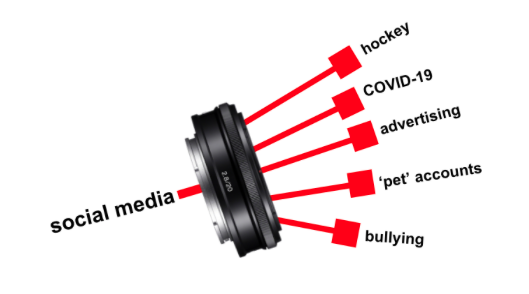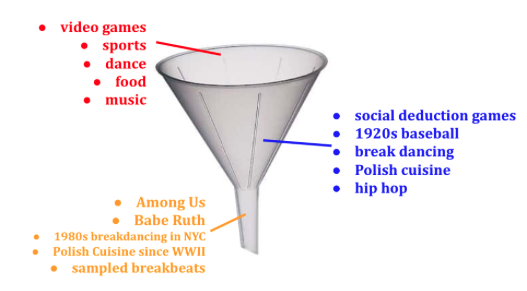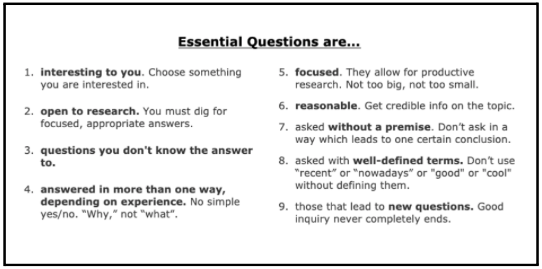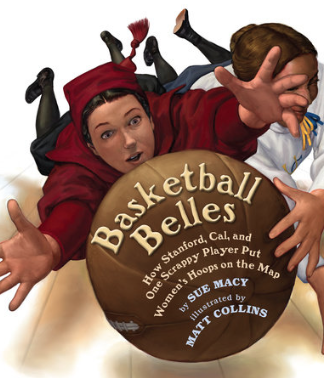At Wilson Middle School my Guided Inquiry Design (GID) class is focused on student’s self-schemas. Whatever topic they would like to research, they study. The challenge is squeezing it all into 16 sessions: the trimester special is split with a tech ed course. This is not a total bummer: one of the things the time restriction breeds is more focused topics. I encourage a lot of sharing within the inquiry community to see how seemingly disparate topics can connect to overarching themes.
II. Sports, the Eternal Topic
Sports is an endless wellspring of fasciation for a middle schooler. If you’re going to let them choose this topic (or ANY topic, really), be prepared to FOCUS THEM. And especially be prepared to focus the sports buff. What is the history of basketball? is a daunting prospect. Narrow it. Who was the first person to play soccer? requires so much definition of terms and theories that it’s a bit absurd. (‘So, what do you mean by “soccer”?’ is a head spinning question…) Make the question essential:
- How did modern basketball come into existence?
- Before the official organization of the NBA, what factors led to its creation?
- What were the other forms of basketball that played pre-NBA?
III. The Inquiry Community
I mentioned this up above, but the community is where the broad themes within research topics begin to connect. In addition to Ms. Bball, I had a second student studying gender inequality, but with a specific focus on wages and the gender pay gap. “Gender pay gap” had returned a newspaper article on Megan Rapinoe’s activism. Rapinoe is a winger for a Major League Soccer team and the US Women’s National Team who filed a lawsuit against the US Soccer Federation, which manages both the men’s and women’s national teams, accusing the organization of gender discrimination. Ms. Bball gets excited.
The Rapinoe share-out activated a schema they had been scanning headlines about: the differences in the media perception between the National Basketball Association and the Women’s National Basketball Association. When it came time to go books, Ms. Bball found Basketball Belles by Sue Macy and read it. This is great: a narrative nonfiction in her area of focus that could be read in a class period and, armed with Post-It notes, she did.
“2. ‘But I think that a lady can be tough and strong as well as refined and polite. She can even play basketball’ (Macy 13).”
With GID, we must push students to go beyond facts. By taking quotes and reading experiences and attaching them with personal motivations, they create vital, essential new knowledge to share. It’s this combo paraphrase-reflection that develops their findings into a new realm of learning. This student wrote:
“I don’t think that it is ok that people think less of women in sports or for people to imagine that women athletes are perfect or a girly-girly. I think it is cool that in Basketball Belles they are in that arena with girls screaming at their top of their lungs instead of it just being boys doing that.”
During Ms. Bball’s presentation, she explained how Sue Macy tells the story of Agnes Morely playing basketball in the first all-female college game, which happened in 1896, five years after James Naismith founded the sport and 53 years before the foundation of the NBA. One of Ms. BBall’s further questions: What factors cause men’s basketball to be the dominant sport in media and in the popular imagination? raises up Macy’s story as evidence that it wasn’t for lack of women wanting to play the game and that these forerunners are important historical figures to raise up.
IV. A Non-Comprehensive List of Non-Fiction Picture Books
Below are some other books I have had success with. Students who are having a more challenging time with the pace of the class or who find books “too big,” or are unable to comprehend the frenetic everywhereness in the layout of an Eyewitness book, or whatever else; these students welcome the feeling of sitting with a picture book and settling in to a story that contains a precedent for their topic.
- The Roots of Rap by Carole Boston Weatherford, with art by Frank Morrison is great for students who have never heard of Curtis Blow or have been listening to triple-rhyme attacks on streaming services. CBW created this rhythmic precis of rap history which explores the Harlem Renaissance, street art, and NYC of the 70s and 80s. It’s loaded with fresh keywords: deejay, block party, LL Cool J, dub, wordplay, Tupac, and much more. It’s a good jumping off point to study the topic, or find a more focused direction from initial interest.
- Different Like Coco by Elizabeth Matthews Fashion pioneer Coco Chanel’s biography deals with class, gender, fashion and a wave of changes set forth by Coco: “Arrogantly simple, her designs shocked everyone.” This book explores the intersection of labor and women’s fashion and class, touching on WWI and Chanel’s emphasizing beauty standards of young, slender women. Backmatter includes a useful timeline.
- Dorothea Lange: The Photographer who the Faces of the Depression by Carole Boston Weatherford, pictures by Sarah Green Another CBW joint— this is a quick, jaunty biography of the famous photographer. In addition to the exciting road narrative the book discusses the lifestyle of an artist and the development of Lange’s craft. It culminates in the famous Florence Owens Thompson photograph. Backmatter includes a simple encyclopedia article-style bio great for quoting.
- Neighborhood Sharks: Hunting with the Great Whites of California’s Farallon Islands by Katherine Roy This book is great for shark researchers because it is an example of a specific case study. Roy sets the book up like V— getting into the specific biology of the killing machines that are Great White Sharks but bokending it with a story of science and conservation. It is especially fruitful for choosing direction of research, as Roy delves into shark’s projectile jaws, evolutionary torpedo-shaped bodies, food chain-ecosystem stasis, optical prowess, and other ideas.
- Nacho’s Nachos: The Story Behind the World’s Favorite Snack by Sandra Nickel and Oliver Dominguez An appreciation of the depth and narrative of a simple snack food, the story of nachos raises the investigation into other foods. Ignacio “Nacho” Anaya Garcia’s claim is pretty verifiable, but food research often involves interesting oral histories and anthropology that makes great research. Backmatter has an original recipe plus an afterward.
- Earmuffs for Everyone: How Chester Greenwood Became Known as the Inventor of Earmuffs by Megan McCarthy A silly little look at the iterative process and a mirror to the self-motivated way of conducting research, Chester Greenwood was a Maine boy with big ears that were cold a lot. The essential understanding of the book is where patents and legends and local history combine to create a story of invention.
- The Wall: Growing Up Behind the Iron Curtain by Peter Sis An award-winning memoir of growing up in Czechoslovakia during the Cold War, this is a lyrical memoir that gets into the people’s history of living behind the Iron Curtain. This is essentially an illuminated journal, which features timelines and the development of Sis’s art through the Soviet Era. At its heart it's a story of making art despite extreme restriction and censorship, but the themes of freedom, the exploration of the Prague spring, and day-to-day experience give a lot to grasp onto.
Caspari, Ann K., Carol Kuhlthau, and Leslie K. Maniotes. Guided Inquiry Design: A Framework for Inquiry in Your School. Santa Barbara: Libraries Unlimited, 2012. Print.
Macy, Sue. Basketball Belles. New York: Holiday House, 2011. Print.
Matthews, Elizabeth. Different Like Coco. Somerville: Candlewick, 2007. Print.
McCarthy, Megan. Earmuffs for Everyone: How Chester Greenwood Became Known as the Inventor of Earmuffs. New York: Simon & Schuster, 2015. Print.
Nickel, Sandra and Oliver Dominguez. Nacho’s Nachos: The Story Behind the World’s Favorite Snack. New York: Lee & Low, 2020. Print.
Roy, Katherine. Neighborhood Sharks: Hunting with the Great Whites of California’s Farallon Islands. New York: Roaring Brook, 2014. Print.
Sis, Peter. The Wall: Growing Up Behind the Iron Curtain. New York, Frances Foster, 2007. Print.
Weatherford, Carole Boston. The Roots of Rap. New York: Little Bee, 2019. Print.
Weatherford, Carole Boston. Dorothea Lange: The Photographer who the Faces of the Depression. Chicago: Albert Whitman & Company, 2017. Print.





